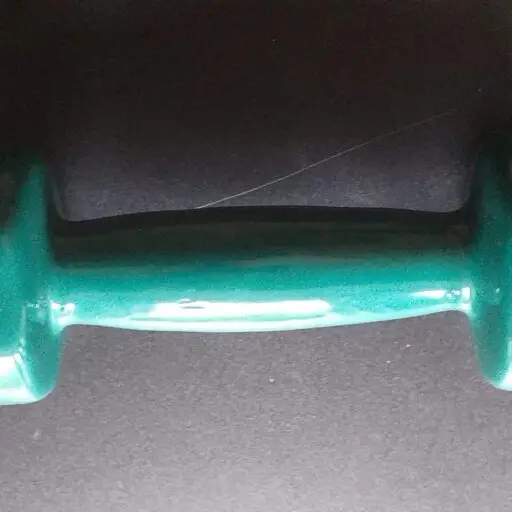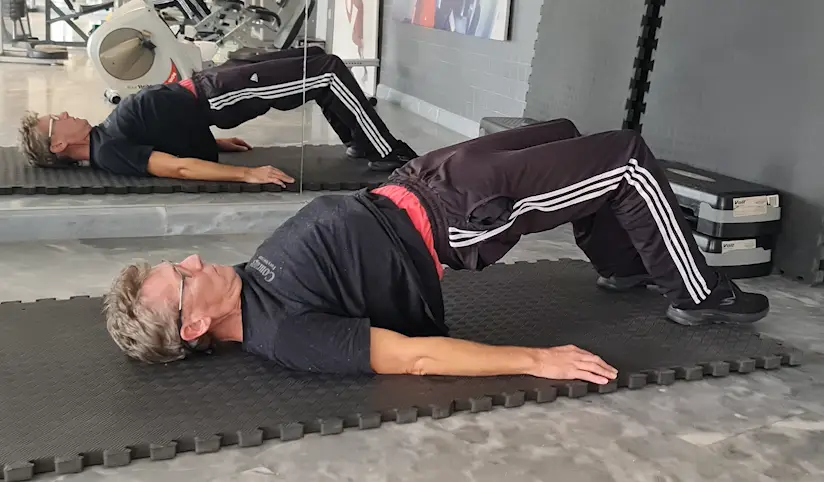All about the Double Leg Bridge Stretch
(Pilates)
BENEFITS & MUSCLES WORKED: Glutes, Hamstrings, Posterior Chain
START POSITION: The Start Position is the classic Pilates Start Position.
Make sure your arms are spread out to the sides (in a V formation) and that the palms of your hands are flat on the floor.
NOTES: Difficulty Level: 15%
Start to push your hips upwards by pressing down with your palms on the floor, and as you do so, also put a slight squeeze on your buttocks. Do not come up too far! Only go up to where your back is straight from the hips to the shoulders. Your head and shoulders stay on the ground. Pause at the top for at least several seconds, then relax back down again. At the bottom, make sure you fully relax again before repeating.
The Double Leg Bridge is sometimes referred to as the ‘Glute Bridge’. It is a widely used and highly effective strengthening exercise for the muscles of the Posterior Chain. It is simple to perform for beginners and should form a fundamental part of any athletic training program. The Posterior chain is a large and important group of muscles that are often overlooked and will degenerate fast if not used regularly – any weakness in your Posterior Chain WILL eventually lead to severe and painful injuries – this is because it is crucial to maintain a healthy balance in the musculoskeletal system so that everything functions in unison and runs smoothly (like a well maintained car engine).
The muscles of the Posterior Chain are:
- Upper Back
- Lats
- Spinal Erectors
- Glutes
- Hamstrings
- Calves
Now look at that list and ask yourself – Have I ever had a painful back injury, spinal or neck injury? Do I know anyone who has had these? If your answer to both questions is no, then I would suggest that maybe you are Mr Bean and have no friends?
The most common areas of injury in sports (and likely in areas of life outside of sports) are all related to some weakness in the Posterior Chain. For example, Hamstring injuries are prevalent among footballers. Calf injuries are commonplace in runners. As an example of a non-sport-related injury, many sedentary office workers often complain of painful necks and shoulders. This is primarily due to poor posture, which is frequently caused by inadequate form in every physical movement we make in our daily lives. Form is an integral part (perhaps the most critical part) of the Mojoh Method.
Another vital point to note is that, in my experience, many injuries to other parts of the body often have their roots in a spinal imbalance. For example, a friend of mine had a serious foot injury – when he was a child, a tractor ran over his foot, and it didn’t heal properly. This resulted in a permanent limp, and, of course, the human body, being the highly adaptable piece of machinery that it is, compensated and adapted; I guess he just learned to live with it. But now, approaching his middle years, he has developed a lower back problem, and I don’t believe that anyone (apart from me) has linked this back to his foot injury. When you limp, you place additional stress on one side of your body, resulting in a muscular imbalance that effectively twists the spine, which can eventually lead to further problems.
And believe it from me (who has had terrible lower back pain), when you get a painful problem in your lower back, everything in your life will become 10 times harder and 10 times slower. What then awaits you is an expensive chiropractor or physiotherapist, or a risky operation. Not to mention the painkillers, muscle relaxants, and other pharmaceuticals. My dogged default answer to all of this imbalanced mayhem would be “Just go to the Gym”.
I am speaking generally and from my own experience – and I am not advising anyone to avoid doctors and pharmaceuticals entirely. That would be daft. We all need them sometimes. They certainly got me out of a few scrapes. I think what I am trying to advise here, above all else, is that people in general should give more thought and priority to their lifestyles around sport, exercise, and the gym – to be more proactive and less reactive to the physical challenges of everyday life. Try to be your Doctor! Believe it and achieve it! Use it or lose it! Seek to make yourself a better, stronger, and more balanced person.
As I look around the gyms in modern times, I observe that many people seem obsessed with training certain areas of their bodies, at the expense of less obvious (or less easy to train) areas. This is a significant problem, and many people need to be educated about the importance of balance and not skipping over the challenging aspects.
For example, if you ask 100 men in any gym to list their favorite workout routines from most liked to least liked, how would it look? Probably something like:
Chest
Biceps
Triceps
Shoulders
Legs
Back
Abs & Core (Pilates and Stretching)
If we ask the same question of 100 women, we find something different, probably something like:
Glutes (Bums)
Abs (Tums) & Core (Pilates and Stretching)
Chest
Legs
Back
Biceps
Triceps
For this discussion, I am not so interested in the differences between men and women. The key point here is that the Back and Posterior chain muscles are never given the priority they deserve. Women do much better than men, but they don’t do well enough, in my opinion. Back in the dark ages, when I was first frequenting gyms, looking for ways to boost my athletic training, I recall a clear divide between men and women in their gym habits. Women would be looking to give their breasts a lift or to get pert bottoms or tight tums. And why not? We all want to look better and feel better, don’t we? Let’s be honest about it, shall we? When the average person looks at a woman, they are unlikely to prioritize the shape of her back, and the same applies when a woman looks at a man. This is because a strong back and posterior chain is far less visually obvious and far less visually appealing than bulging biceps, pecs like Superman, or high-standing breasts.
A few years ago, I met a man in a gym, and I observed that his form was excellent and that he consistently worked hard. We got talking later in the locker room, and what he said to me had a significant impact on me, slightly changing my way of thinking. I had asked him what he was training for. And his answer was simply that he prioritized health and well-being in his life—and that he had decided to train only his back and core muscles. This astounded me. But I had to agree that it sounded like an excellent idea. We talked about injury prevention and the importance of the spine. I related this to my own lower back problems earlier in my life. For this reason, I had already started increasing the amount of Back and Pilates exercises during my gym visits. I had begun to build on my knowledge and repertoire, mixing my old-school experience with modern ideas and equipment. And so I became keenly interested in Balance and Symmetry, and when I married this together with my lifelong obsession for Technique and Form,
I began to realize that I had developed a new type of training method, which seemed to encompass everything from technique to injury prevention, psychology, and diet. This is how the Mojoh Method came to be.

